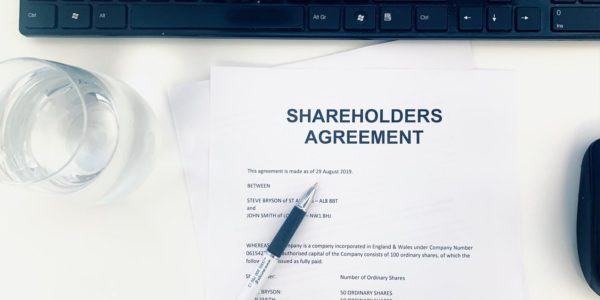This guide will inform you of the key benefits of a shareholders’ agreement and reasons for choosing to implement one within your organisation. Even if you have a new company with very few staff, or you’re running the business with just one other person, having a formal agreement in place can prevent potential complications further down the line.
What is a shareholders’ agreement?
A shareholders’ agreement is a legally binding arrangement established between a company’s shareholders (members). It governs the relationship between members, protects their individual and collective rights, and regulates the management of the organisation itself. Without such an agreement, disputes between shareholders have the potential to grind a company to a halt.
Providing for many eventualities, a shareholders’ agreement works alongside the articles of association to clarify the rights of members, stipulate the rules that must be followed when running the company, and provide clear policies and procedures for share ownership and dispute resolution. Such explicit provisions are valuable to all members, whether minority or majority shareholders.
Whether you’re setting up a business with family or close friends, or becoming a shareholder in a larger organisation, a shareholders’ agreement will help to protect everyone’s interests and avoid disputes and disagreements between members.
How does this differ from the articles of association?
There are notable differences between a shareholders’ agreement and articles of association (which form part of the company’s constitution, along with the memorandum of association).
The articles of association form a contract between the company and shareholders, whereas a shareholders’ agreement forms a contract between the shareholders themselves. Although they both contain rules on how a company operates, there are certain mandatory elements of the articles (prescribed by statute), whereas a shareholders’ agreement is essentially a private contract, so it’s much more flexible.
Since the shareholders’ agreement is a private agreement, it remains confidential between the parties involved – whereas the articles of association is a public document which must be filed with Companies House.
Another difference is the manner in which the rules are decided: a shareholders’ agreement normally requires 100% of shareholders to agree any changes to its contents, as opposed to the statutory 75% for the articles of association.
Although there are “model” (standard default) articles of association prescribed by the Companies Act, there is no such model in respect of a shareholders’ agreement.
What are the main reasons to put in place a shareholders’ agreement?
The main reason for putting a shareholders’ agreement in place is to protect the shareholders and the company. For example, if you don’t have an agreement in place, the majority shareholders are able to make important decisions that are not necessarily in the best interest of minority shareholders. Decisions that should include everyone might be about the appointment/removal of directors, issuing of new shares, etc.
Another advantage of having the agreement is the flexibility that it offers in comparison to the basic constitution, as no standard form exists for shareholders’ agreement. Furthermore, because it is a private document, commercially sensitive information can be included.
How do you implement a shareholders’ agreement and when is the best time to do so?
The ideal time to put a shareholders’ agreement in place is when you start the company. Fallouts between shareholders can happen – but if the agreement is implemented from the start, disputes are limited by the rules already agreed.
If you already have an existing company, but never got around to implementing an agreement, it’s not too late. In fact, when new shareholders come on board, this can be a good time to implement a shareholders’ agreement.
It is always advisable to enlist a solicitor or an accountant to help set up and manage the agreement. Although there isn’t a legal requirement to do this, the benefits of having a comprehensive document in place is huge – and although there is generally a cost for doing so, this will potentially be offset by the savings made on avoiding any unnecessary disputes further down the line.
Alternatively, if you prefer a DIY solution, there are many templates available online, usually for a fee. A template will help you compile the contents of your agreement in a step-by-step way.
If you decide to purchase a template, there are considerations worth thinking about, so you can choose the right template to suit your organisation. These include:
- Coverage of topics – it is better to have a longer, thorough document that covers relevant matters in detail
- Language – the document needs to be written in a plain and understandable language, jargon isn’t required
- Relevance – it’s always worth checking when the template was last updated and getting the most up-to-date template
What are the key provisions contained in a shareholders’ agreement?
There are wide-ranging provisions and clauses that can be included in a shareholders’ agreement, bespoke to suit your organisation. However, some of the typical key clauses include:
The company’s activities
It is imperative to set out what the company does and its aims. This can include salaries and earnings; future plans; decision-making processes; and arrangements for when business owners exit the company – sometimes under different circumstances.
Issue and transfer of shares
Provisions for issuing shares should be agreed upon and explained clearly. Any plans that arise to issue shares in order to raise funds, should be balanced against concerns about existing shareholders’ shares being diluted.
The subject of transferring shares is an important factor. If shareholders wish to sell their shares, provisions should be in place – this applies to unexpected changes, such as a member exiting the company or in the event of death. There are legal obligations to obey.
Under Part 17, Chapter 3 of the Companies Act 2006, if a company plans to allot equity (shares), they must be offered to all existing shareholders first, on a pre-emptive basis. This is referred to as the pre-emptive rights of equity. When a shareholder leaves the company, their shares must be offered to the remaining shareholders.
Payment of dividends
A dividend policy can be included in the agreement. Usually, the regulations (along with duration and percentages of profit sharing) will be detailed. New tax laws came into force in 2016 for dividends – GOV.UK provides full details of tax on dividends.
Competition restrictions
Companies often choose to include a non-compete clause in their shareholders’ agreement. This will prevent shareholders from being able to work for a rival company or indeed setting up their own company. Although difficult to police, the restriction is intended to prevent an employee from disclosing confidential intellectual property or sensitive commercial information. Although your company may be small, it is worth protecting the intellectual property within your workforce as best you can.
Banking and auditors
The company’s bank, auditors, and registered address are usually agreed and included, along with the accounting schedule. Unless a unanimous agreement is made, these details are not usually changed.
Termination of agreement
Within the agreement, it should be stipulated what the clause is in the event of the agreement being terminated. There are three common reasons for terminating an agreement:
- when ALL shareholders are in agreement (perhaps because the company is being sold)
- if there has been a breach in contract (if this happens, the agreement can be terminated unless there are clauses for mediation)
- if one of the shareholders is leaving the company (provisions should stipulate what will happen in this scenario)
There can be other areas of your business that you wish to include in your agreement. It is up to you and your shareholders to decide what to incorporate.
How does the agreement help minority and majority shareholders?
Typically, a minority shareholder will have a lot less control over a company than a majority shareholder. Sometimes their control is so limited that they have little or no say in the company decisions, e.g., if there are just two shareholders with unequal shares. Often is the case where the overall power sits with just one or two key shareholders.
Historically companies operate by going with a majority decision. Unfortunately, laws to protect minority shareholders’ can be difficult to enforce. For a minority shareholder, it is beneficial to have an agreement which states that ALL shareholders have a say in approving certain decisions – and especially ones that will impact on the future of the company, e.g. the enrolment or removal of directors; financial borrowing; changes in trading; etc.
Likewise, majority shareholders need to be protected too. Sometimes a drag along clause is included in a shareholders’ agreement (if it is not already part of the articles of association). This is exercised when a majority shareholder would like to sell their shares to a third party, but when the third party wishes to purchase 100% of the shares in the company. The drag along clause in this instance can force any minority shareholders, who may otherwise refuse to sell and therefore block the sale, to sell to that same third party on the same terms.
Should I put in place a shareholders’ agreement?
Although there is no law forcing you and your company to put a shareholders’ agreement in place, it will provide greater protection for your company and its shareholders. It is important that all parties understand their rights and responsibilities from the start. Although the company’s constitution (articles of association and memorandum) can serve as the foundations, a shareholders’ agreement provides further reassurance that everyone is on the same page and enables problems to be nipped in the bud, generally saving time and money in the long run.
Please note that the information provided in this article is for general informational purposes only and does not constitute legal, tax, or professional advice. While our aim is that the content is accurate and up to date, it should not be relied upon as a substitute for tailored advice from qualified professionals. We strongly recommend that you seek independent legal and tax advice specific to your circumstances before acting on any information contained in this article. We accept no responsibility or liability for any loss or damage that may result from your reliance on the information provided in this article. Use of the information contained in this article is entirely at your own risk.






Join The Discussion
Comments (2)
This is really interesting, thank you.
But what happens if one shareholder decides they do not want to sign the shareholder agreement but all the other shareholders have signed? Do you need to make adjustments for one shareholder and then go back and change all the other agreements and get them signed all over again?
Thank you for your comment Peni!
If a shareholder has not signed an agreement that all other shareholders have, then they will not be subject to the provisions of that agreement. In most cases, it would seem the agreement might need to be amended in a manner that all shareholders, including the one that originally refused to sign, are happy with and agree to (by signing).
Kind regards,
The QCF Team